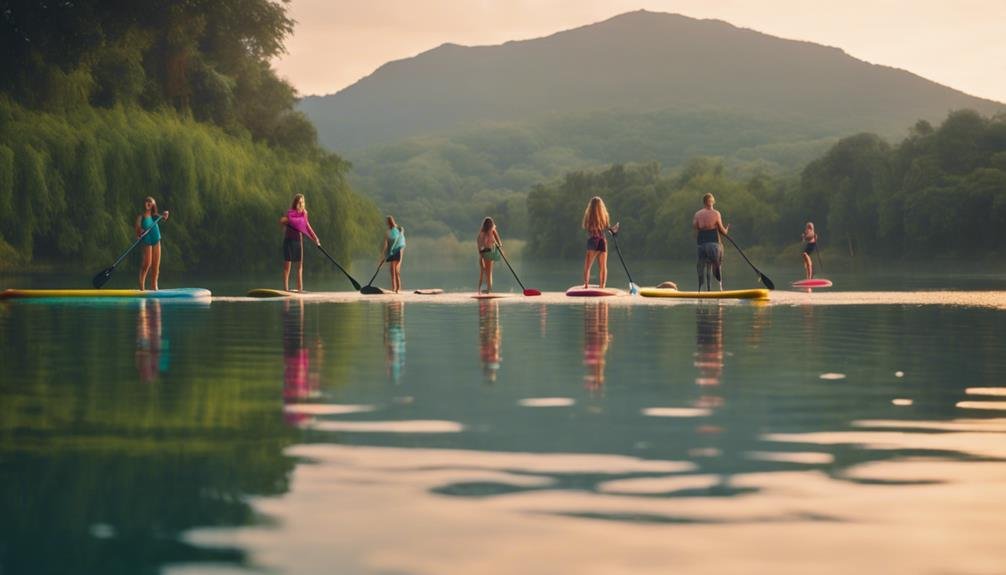
Stand-up paddleboarding (SUP) has quickly become one of my favorite outdoor activities. It combines the thrill of adventure with a sense of tranquility as I paddle across calm waters. For beginners, choosing a stable, all-around board around 30 inches wide is key. I've found that proper stance and balance are essential, with feet shoulder-width apart and a relaxed grip on the paddle. Safety's vital too, so I always wear a PFD and keep a whistle handy. If you're curious about gear options, ideal locations, and more techniques, there's much more to explore!
Key Takeaways
- Choose the right SUP board based on your skill level and intended water conditions, considering options like inflatable and rigid boards.
- Learn essential paddling techniques, including proper stance, grip, and stroke, to enhance stability and efficiency.
- Prioritize safety by using a personal flotation device (PFD), leash, and other essential equipment while paddling.
- Understand water conditions, including tides and weather patterns, to navigate safely and effectively.
Overview of Stand-Up Paddleboarding
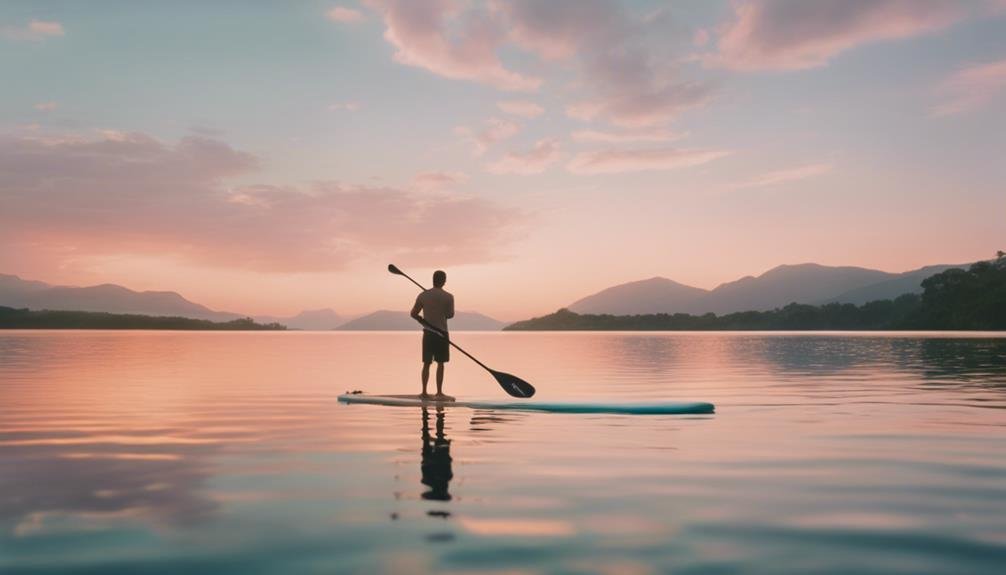
Stand-up paddleboarding, or SUP, combines the thrill of surfing with the tranquility of kayaking, making it an exciting way to explore the water while getting a full-body workout. The origins of stand-up paddleboarding trace back to ancient Polynesian cultures, where islanders used it for fishing and transportation.
Fast forward to the early 2000s, and I can see how this ancient technique has surged in popularity around the world, capturing the hearts of water enthusiasts everywhere.
I love gliding across calm lakes or riding gentle ocean waves, feeling the sun warm my skin and the breeze in my hair. As I maneuver my board, I can't help but appreciate how SUP offers a sense of freedom that few other sports can match.
With a paddle in hand, I'm in control, able to navigate serene waters or explore hidden coves at my own pace. This rise in popularity of SUP has also inspired a vibrant community of paddlers who share tips, techniques, and experiences.
Whether I'm participating in a local race or simply enjoying a sunset paddle with friends, I feel connected to nature and energized by the experience.
Benefits of Paddleboarding
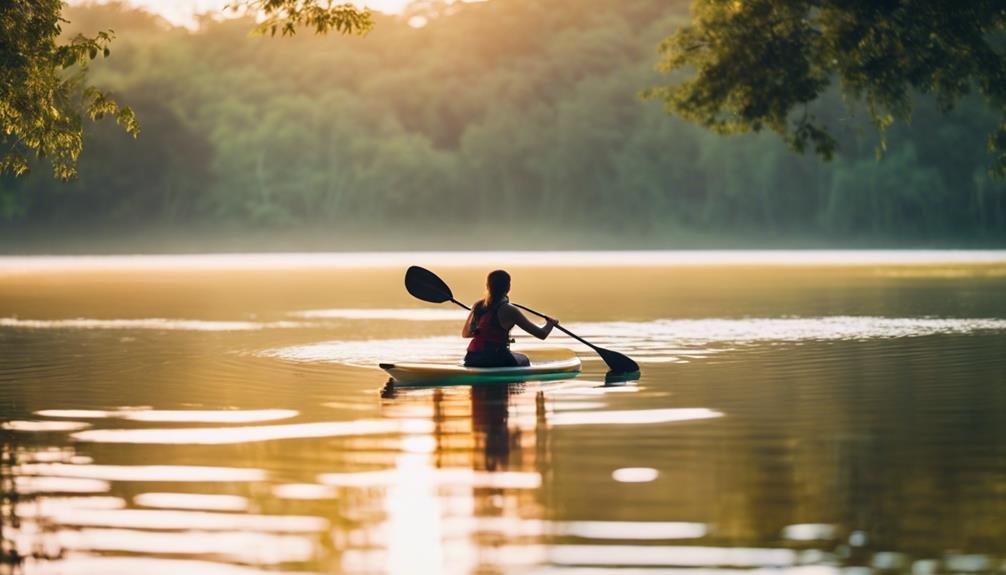
When I paddleboard, I quickly notice how it boosts my physical fitness while also clearing my mind.
The blend of balancing, paddling, and the serene water around me works wonders for my body and mental well-being.
It's amazing how such a simple activity can offer so many benefits!
Physical Fitness Advantages
Paddleboarding offers a unique blend of cardio and strength training that keeps me feeling energized and fit while enjoying the great outdoors. As I glide across the water, I can feel my heart rate rising, which contributes to improved cardiovascular health. It's exhilarating to know that each stroke not only propels me forward but also serves as a workout for my entire body.
The balance required on the board engages my core muscles, leading to increased muscle tone, particularly in my arms, legs, and abs. I love how paddleboarding isn't just about the destination; each session becomes an opportunity to build strength while soaking up the sun and fresh air. The rhythmic motion of paddling feels almost meditative, allowing me to connect with nature while getting fit.
Whether I'm cruising on a calm lake or tackling gentle waves, I appreciate how paddleboarding challenges my body in a fun, dynamic way. It's an activity that invites me to explore new places and embrace a sense of freedom, all while reaping the physical rewards. If you're looking for a way to enhance your fitness journey, paddleboarding might just be the perfect adventure for you!
Mental Health Benefits
Embracing the tranquility of the water while paddleboarding has a remarkable way of soothing my mind and enhancing my overall mental well-being. Each stroke feels like I'm carving away the stress of daily life, allowing me to immerse myself in a beautiful mindfulness exploration. The rhythmic motion of gliding across the water brings a meditative quality that quiets my racing thoughts and helps me reconnect with the present moment.
During those serene outings, I've found the perfect escape to clear my mind. The gentle lapping of the waves and the fresh breeze create an atmosphere of calm, promoting stress reduction like nothing else. I can let go of my worries and simply exist in that blissful space, where nature and I become one.
The freedom I feel on the water is unparalleled. Paddleboarding isn't just a physical activity for me; it's a sanctuary for my mental health. With every paddle, I gain a renewed sense of clarity and purpose. So, if you're seeking a way to nurture your mind and spirit, I highly recommend grabbing a paddle and heading out onto the water. You won't regret it.
Choosing the Right SUP Board
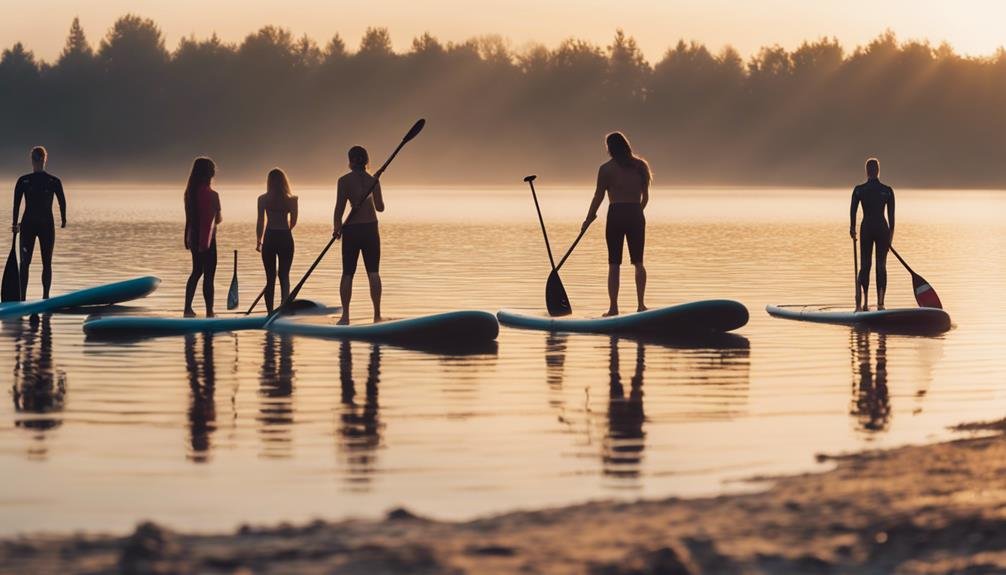
Choosing the right SUP board can make all the difference in your experience on the water, so let's break down what you need to consider before making a purchase.
First up is sizing your paddleboard. Generally, longer boards glide better and are great for flat water, while shorter boards offer more maneuverability for surfing. I've found that a width of around 30 inches provides stability, perfect for beginners like me who want to feel secure while paddling.
Next, let's talk about choosing board material. Inflatable boards are fantastic for portability and storage; they're lightweight and easy to transport. On the other hand, hard boards made of fiberglass or epoxy offer better performance and durability in rough conditions. Think about where you'll be paddling most—calm lakes or ocean waves—to help guide your decision.
Ultimately, I believe the right SUP board is about matching your style and intended use. So, take your time, do your research, and trust your instincts. You want a paddleboard that feels like an extension of yourself, ready to carry you into your next adventure on the water!
Essential Paddleboarding Gear
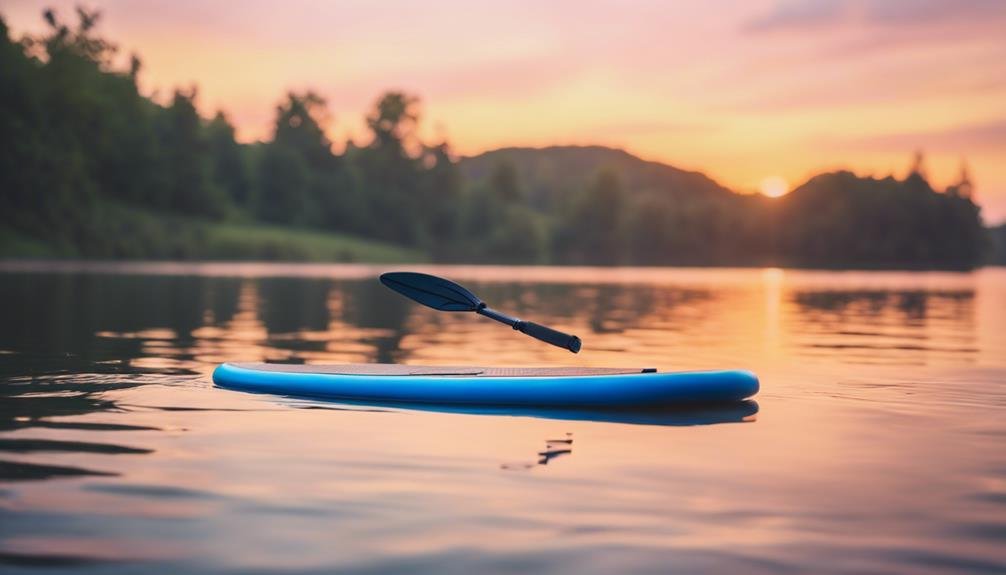
When I first started paddleboarding, I quickly learned that having the right gear can make all the difference in my experience.
Understanding the various paddleboard types and ensuring I'd the must-have safety equipment helped me feel confident and secure on the water.
Let's explore these essentials so you can enjoy your paddleboarding adventures to the fullest!
Paddleboard Types Explained
Understanding the different types of paddleboards can make all the difference in finding the right gear for your adventure on the water. When I first started paddleboarding, I was overwhelmed by the options. I quickly learned that the two main types are inflatable SUPs and rigid SUPs, each offering unique benefits.
Inflatable SUPs are lightweight and portable, perfect for travel and storage.
Rigid SUPs offer better stability and speed, ideal for performance-focused paddlers.
All-Around Boards are versatile and great for beginners, suitable for various water conditions.
Touring Boards are longer and narrower, designed for distance paddling and cruising.
Surf Boards are specifically designed for wave riding, offering maneuverability and agility.
Choosing the right paddleboard really depends on your needs and preferences. If you crave the freedom to explore new places easily, inflatable SUPs are a fantastic choice. On the other hand, if you're looking to race or surf, rigid SUPs might be your best bet. Ultimately, understanding these types will help you make an informed decision, allowing you to embrace the water with confidence and excitement.
Must-Have Safety Equipment
Safety should always be a top priority, so equipping yourself with the right gear is essential for a worry-free paddleboarding experience. I can't emphasize enough how important it is to have the proper safety equipment when I hit the water. Not only does it give me peace of mind, but it also ensures I'm prepared for any unexpected situations.
Here's a quick guide to must-have safety gear:
| Safety Equipment | Purpose |
|---|---|
| Personal Flotation Device (PFD) | Keeps me buoyant in case I fall in. |
| Leash | Prevents my board from drifting away. |
| Whistle | Alerts others if I'm in distress. |
| First Aid Kit | Handles minor injuries while I'm out. |
| Dry Bag | Protects my essentials from water damage. |
Regular safety gear maintenance and a paddleboard safety inspection before each outing are crucial. I always check my PFD for any wear and tear and ensure my leash is intact. Staying prepared allows me to embrace the freedom of paddleboarding without worry.
Safety Tips for Beginners
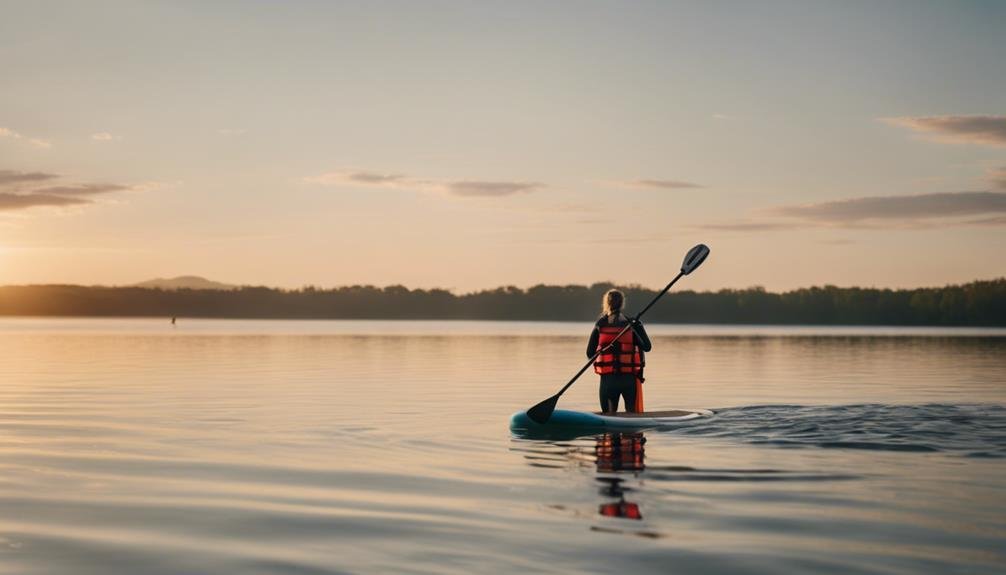
Before hitting the water, I always make sure to check my gear and familiarize myself with essential safety measures to ensure a fun and secure paddleboarding experience. Safety is key, especially for beginners like me. It's crucial to embrace the freedom of the open water while staying aware of my surroundings.
Weather awareness: Always check the forecast before paddling. Sudden changes can make for a rough ride.
Emergency preparedness: I keep a whistle or signal device handy in case I need to call for help.
Wear a personal flotation device (PFD): It's not just a good idea; it's often required by law.
Stay hydrated: I make sure to bring water, as it's easy to forget to drink when I'm having fun.
Paddle with a buddy: There's safety in numbers, and it's always nice to share the adventure.
Basic Paddling Techniques
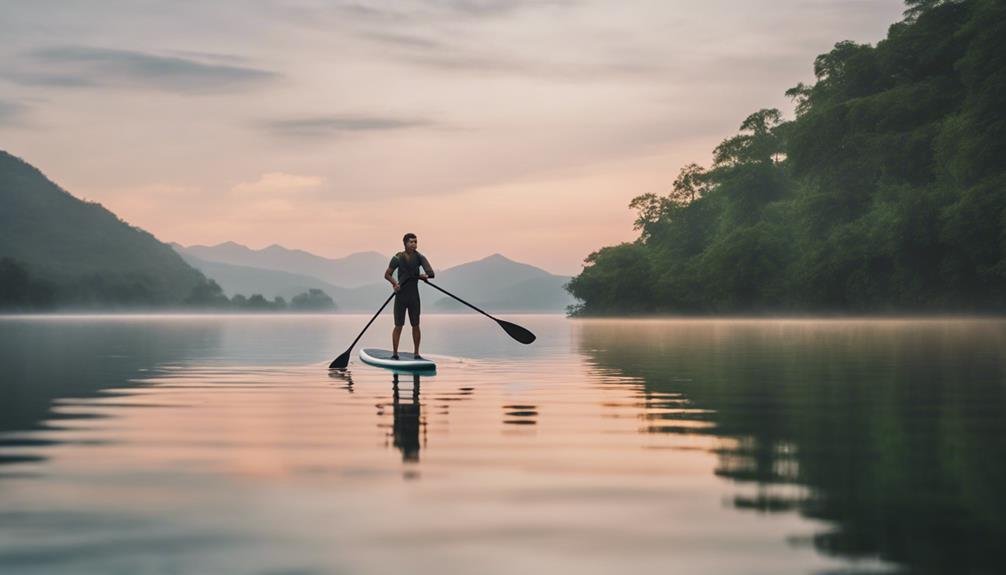
When I first started paddleboarding, mastering the basic paddling techniques made all the difference.
I quickly realized that having the right stance, grip, and stroke technique is crucial for maintaining balance and moving efficiently.
Let's break down these essential points to help you paddle like a pro!
Proper Stance and Balance
Finding the right stance and maintaining balance on your stand-up paddleboard is crucial for enjoying the experience and mastering basic paddling techniques. I've learned that achieving optimal body alignment not only enhances my stability but also improves my paddling efficiency.
To find your ideal stance, consider the following tips:
- Feet shoulder-width apart: This gives you a solid base to balance on.
- Bend your knees slightly: A slight bend helps absorb any movement and keeps you steady.
Adjusting stance dynamically: Be ready to shift your weight as conditions change, like waves or currents.
Engage your core: A strong core supports your balance and allows for better paddle strokes.
Effective Paddle Grip
Mastering an effective paddle grip is essential for efficient strokes and overall control on the water. When I'm out on my board, I make sure my hands are spaced comfortably apart, with one hand on the top of the paddle and the other gripping the shaft a bit lower. This grip gives me the leverage I need for smooth strokes.
I often make paddle position adjustments based on my speed and the conditions around me. When paddling in calm waters, I keep the paddle vertical, but as I pick up speed or navigate through waves, I tilt it slightly for better blade angle control. This small shift can make a huge difference in my paddling efficiency, allowing me to glide effortlessly across the surface.
I also pay attention to my grip pressure; it shouldn't be too tight or too loose. A relaxed grip helps me maintain fluidity in my strokes and reduces fatigue. With practice, I've found that the right paddle grip not only improves my performance but also enhances my connection with the water, allowing me to fully embrace the freedom of paddleboarding.
Stroke Technique Essentials
Good stroke technique is the cornerstone of efficient paddling, and I've learned that the key lies in a blend of rhythm, body mechanics, and proper paddle placement. As I glide over the water, I focus on my paddle positioning and core engagement to maximize my strokes. Each movement becomes a dance—fluid and purposeful.
Paddle Angle: Ensure the blade enters the water at a slight angle to reduce drag.
Body Rotation: Use your torso to drive the stroke, rather than just your arms, to conserve energy.
Grip Pressure: Maintain a relaxed grip on the paddle to avoid fatigue.
Stroke Length: Adjust your stroke length based on the current conditions; longer strokes yield more speed.
Timing: Develop a consistent rhythm that feels natural to you, allowing for smoother transitions.
Understanding Water Conditions
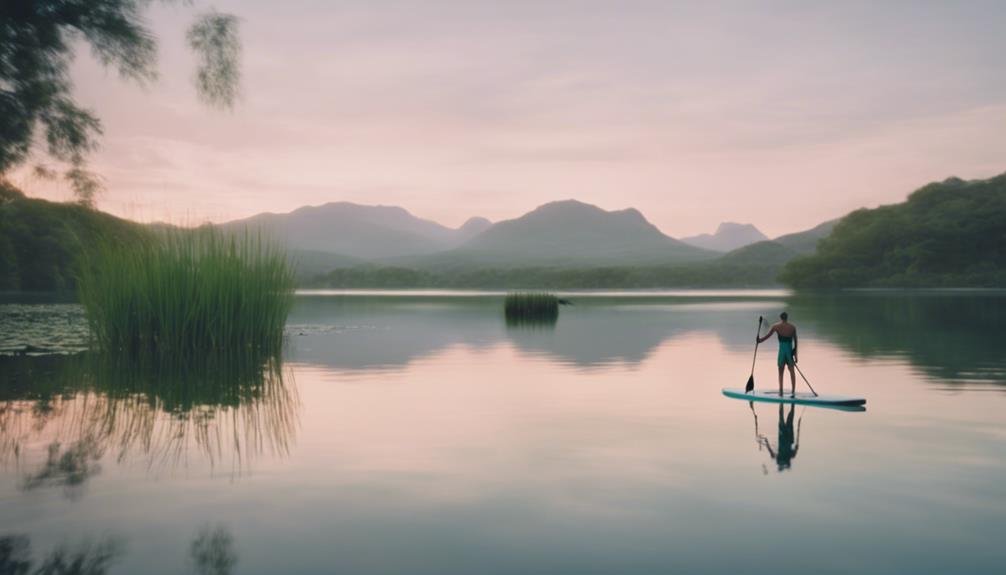
Before I hit the water on my stand-up paddleboard, I always take a moment to assess the conditions, as they can make a huge difference in my paddling experience. Understanding tidal currents is crucial; they can change the way I navigate and affect how much energy I expend.
If I'm heading out at high tide, I might find a stronger current pushing me along, which can feel exhilarating. However, when the tide goes out, I need to be cautious, as the currents can become tricky and even dangerous.
Weather patterns also play a vital role in my adventures. A sunny day with calm winds invites me to explore further, while sudden gusts or storm clouds can signal it's time to head back. I've been caught off guard before, and trust me, it's not fun battling against the elements. I always check the forecast and keep an eye on the sky before I paddle out.
Finding the Best Paddleboarding Locations
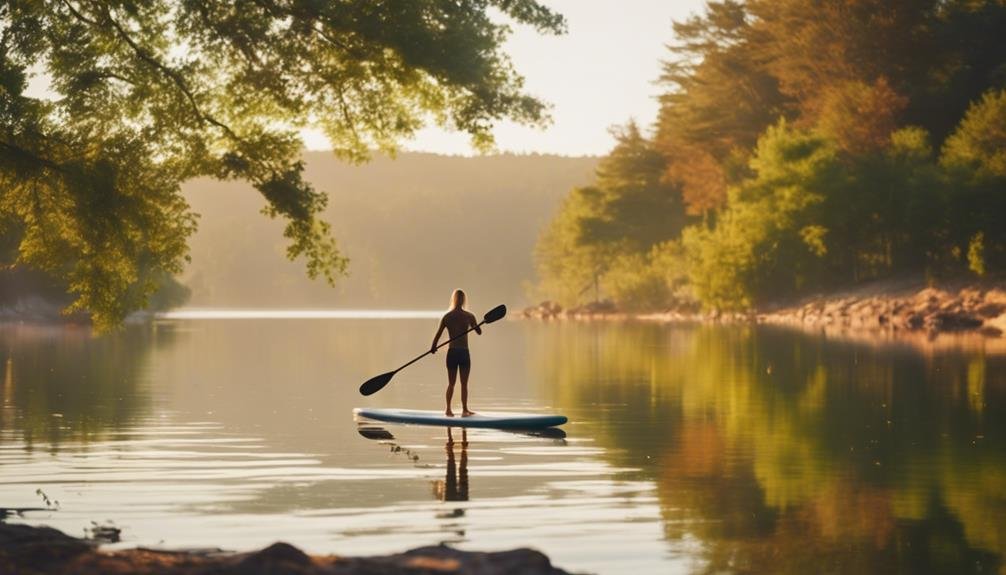
After getting a solid grasp on the water conditions, I'm excited to explore the best paddleboarding locations that can offer the perfect backdrop for my adventures. The thrill of gliding over calm waters while soaking in stunning scenery is truly unmatched.
Scenic Lake Locations: Lakes like Lake Tahoe and Flathead Lake offer breathtaking views and crystal-clear waters.
Beginner Friendly Rivers: Rivers such as the Yampa River in Colorado are gentle and perfect for those just starting out.
Coastal Areas: Beaches with calm waves, like those in the Florida Keys, provide a unique experience.
Nature Reserves: Exploring places like the Everglades lets me paddle through lush wetlands teeming with wildlife.
Local Parks: Many parks have designated paddleboarding areas, making it easy to enjoy the outdoors close to home.
Finding the right location not only enhances my paddleboarding experience but also lets me connect with nature in an exhilarating way. So, grab your board and get ready to discover these amazing spots!
Common Mistakes to Avoid
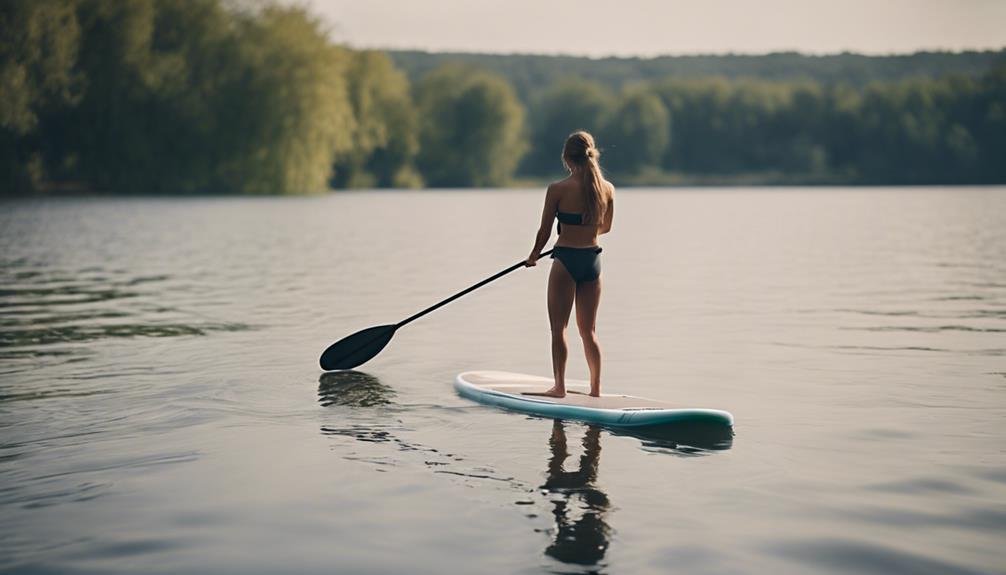
Avoiding common mistakes while paddleboarding can make the difference between a fun outing and a frustrating experience. One of the biggest pitfalls I encountered was improper foot positioning. Standing too far forward or backward on the board can throw off your balance and lead to a splashy fall. I've learned that keeping my feet shoulder-width apart, centered on the board, helps me maintain stability and control.
Another mistake I made early on was using an incorrect paddle angle. I initially thought I could just paddle straight down, but that led to fatigue and inefficient strokes. Instead, I found that keeping the paddle at a slight angle allows me to harness the power of each stroke, propelling me forward with ease.
It's also essential to keep my gaze forward rather than looking down at my feet. This simple adjustment helps me stay upright and aware of my surroundings, enhancing the overall experience. By steering clear of these common errors, I'm able to enjoy the freedom and exhilaration that paddleboarding offers, making every outing a memorable adventure!
Resources for Further Learning
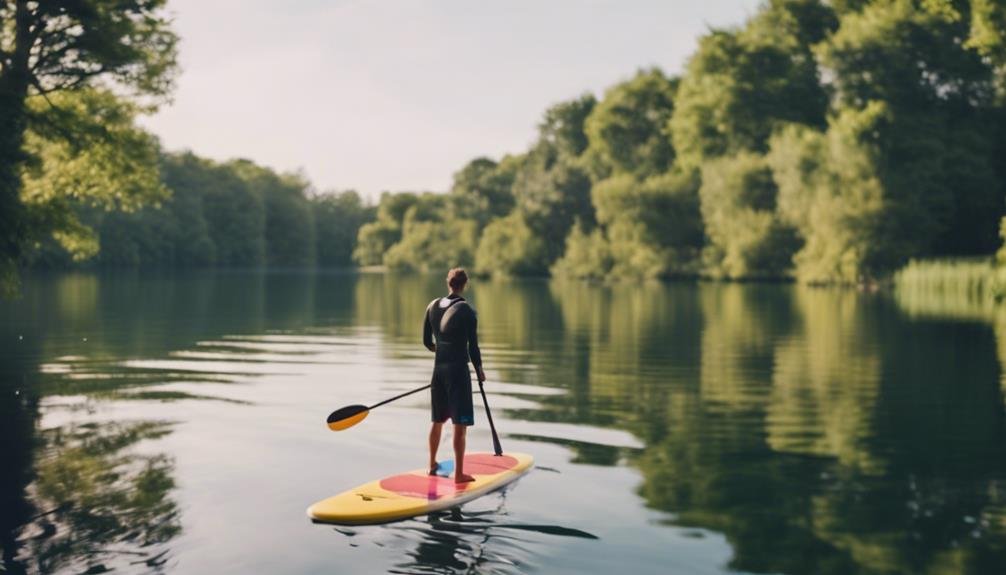
To dive deeper into the world of stand-up paddleboarding, I've found a variety of resources that can enhance my skills and knowledge. Exploring these options not only fuels my passion but also provides me with the confidence to glide across the water like a pro. Whether I'm looking for paddleboarding tutorials or online paddleboarding lessons, these resources have been invaluable in my journey.
YouTube Channels: There are countless channels dedicated to paddleboarding techniques, tips, and tricks.
Online Courses: Websites like Udemy and Skillshare offer structured lessons that cover everything from basics to advanced maneuvers.
Local Paddleboarding Clubs: Joining a club can connect me with experienced paddlers and provide hands-on learning.
Social Media Groups: Platforms like Facebook and Instagram have vibrant communities where I can share experiences and ask for advice.
Books and E-books: There's a wealth of literature available that dives into paddleboarding techniques and safety tips.
Conclusion
In conclusion, getting into stand-up paddleboarding has been an eye-opening experience for me.
It's not just a fantastic workout; it's also a great way to connect with nature and unwind.
Did you know that over 3 million people in the U.S. paddleboard each year? That's a testament to how enjoyable and accessible this sport is!
So grab your board, explore new waters, and embrace the adventure—trust me, you won't regret it!
